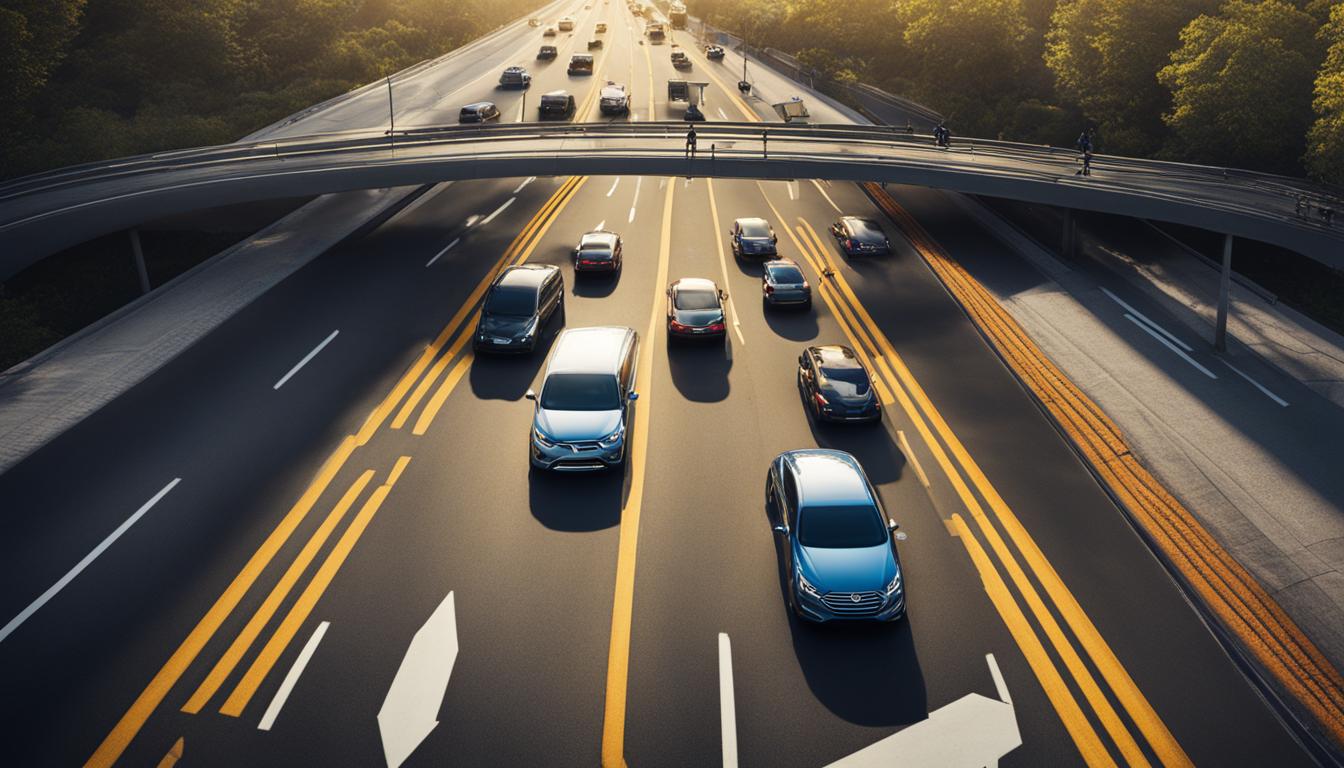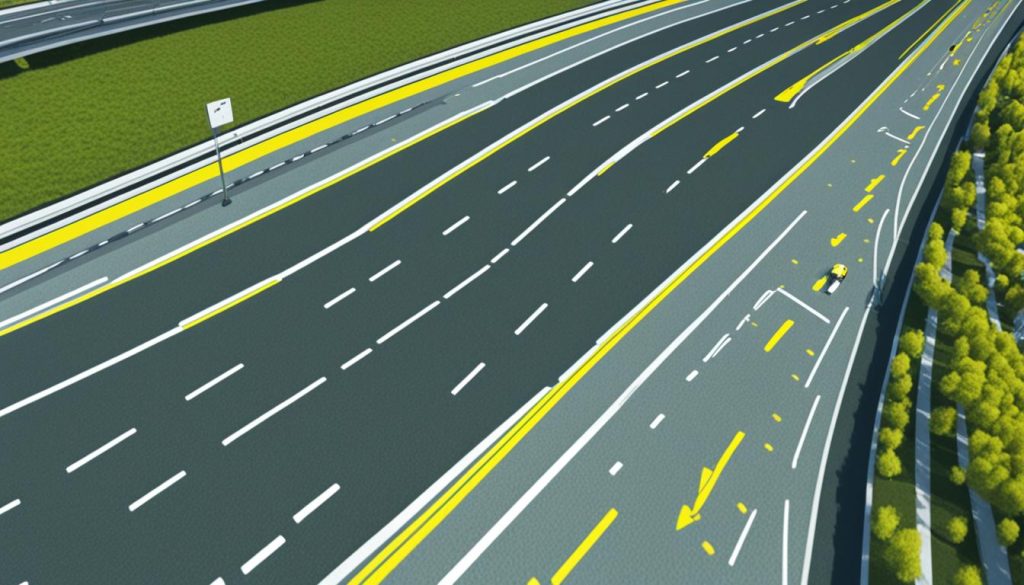
Understanding What Is a Travel Lane Explained
If you’ve ever driven on a road, you’ve encountered travel lanes. But what exactly is a travel lane, and why is it important in traffic management? In this article, we will delve into the definition, characteristics, and types of travel lanes, as well as their regulations and the evolution of lane markings.
A travel lane is a designated part of a roadway intended for the movement of vehicles. It is a single line of traffic that helps control and guide drivers, reducing traffic conflicts. Public roads typically have at least two lanes, one for traffic in each direction. Travel lanes are usually separated by lane markings. Major highways often have multiple lanes in each direction, separated by a median.
Key Takeaways:
- A travel lane is a designated part of a roadway for the movement of vehicles.
- Travel lanes play a crucial role in traffic management and reduce congestion.
- There are different types of travel lanes, including through lanes and auxiliary lanes.
- Travel lane width varies based on factors such as speed limits and traffic volume.
- Travel lane rules and regulations must be followed by drivers to ensure safety.
Importance of Travel Lanes in Traffic Management
Travel lanes play a crucial role in traffic management. They help regulate the flow of vehicles and reduce congestion on roadways. By providing a designated space for vehicles to travel, travel lanes ensure that traffic moves smoothly and efficiently. Properly marked travel lanes also help drivers navigate intersections, exits, and entrances more safely. Additionally, travel lanes make it easier for emergency vehicles to pass through traffic quickly.
| Benefits of Travel Lanes in Traffic Management |
|---|
| Regulate vehicle flow |
| Reduce traffic congestion |
| Enhance driver safety |
| Facilitate emergency vehicle access |
Travel lanes create order and structure on the roads, allowing vehicles to move efficiently without unnecessary delays. Without travel lanes, traffic would be chaotic and unpredictable. It would be challenging for drivers to navigate intersections and make necessary maneuvers. By designating specific areas for vehicle travel, travel lanes provide a clear pathway for drivers to follow, minimizing confusion and potential accidents.
Moreover, travel lanes help prevent traffic congestion by separating vehicles into organized streams. When each vehicle occupies its designated lane, the overall traffic flow improves, reducing the likelihood of bottlenecks and gridlock. Consistent movement in travel lanes allows traffic to reach its destination in a timely manner, benefiting commuters, delivery services, and emergency responders alike.
Travel lanes also contribute to driver safety. Using properly marked travel lanes helps drivers make informed decisions and execute maneuvers safely. Lane markings guide drivers on how to approach intersections, make turns, and merge onto highways. These visual cues help prevent collisions and promote smooth traffic transitions.
When drivers can clearly see the designated travel lanes, they can anticipate the actions of other vehicles, reducing the potential for accidents. Emergency vehicles, such as ambulances and fire trucks, rely on travel lanes to navigate through traffic efficiently, ensuring prompt response times in critical situations.
importance of travel lanes in traffic management cannot be overstated. By providing structure, order, and safety on roadways, travel lanes enable a well-functioning transportation system that benefits all road users. Understanding and respecting the role of travel lanes is essential for maintaining efficient traffic flow and minimizing congestion.
Definition and Characteristics of Travel Lanes
A travel lane is a specific portion of a roadway designated for the movement of vehicles. It is marked by lane markings, such as lines painted on the road surface. Travel lanes are designed to provide safe and efficient paths for traffic to flow in a particular direction.
The characteristics of travel lanes include:
- Width: Travel lanes are typically wide enough to comfortably accommodate one vehicle. The width may vary depending on the road type and traffic volume.
- Lane markings: Lane markings, such as solid or dashed lines, help guide drivers and indicate the boundaries of the travel lane.
- Traffic direction: Each travel lane is intended for traffic flow in a specific direction, whether it is for oncoming or outgoing vehicles.
- Separation: Travel lanes are separated from adjacent lanes by lane markings or physical barriers, ensuring organized and safe traffic movement.
A travel lane is like a dedicated pathway on the road, providing a clear direction for vehicles to follow. It ensures that traffic moves smoothly, reducing the risk of accidents and congestion. By understanding the characteristics of travel lanes, drivers can navigate the roadways safely and efficiently.
| Characteristics | Description |
|---|---|
| Width | Typically wide enough to accommodate one vehicle comfortably |
| Lane markings | Guide drivers and indicate the boundaries of the travel lane |
| Traffic direction | Intended for traffic flow in a specific direction |
| Separation | Separated from adjacent lanes by lane markings or physical barriers |
Types of Travel Lanes
When it comes to travel lanes, there are different types designed to accommodate various traffic movements and ensure safe and efficient travel on roadways. Understanding these types can help you navigate the roads with ease.
Through Lanes
Through lanes are the most common type of travel lanes. They are dedicated to continuous traffic flow without any interruptions. When you’re driving on a through lane, you can expect to maintain a consistent speed and continue on your intended route.
Auxiliary Lanes
Auxiliary lanes are used to separate entering, exiting, or turning traffic from the through traffic. They provide additional space for vehicles to make lane changes or perform specific movements without disrupting the flow of traffic. Common examples of auxiliary lanes include entrance ramps, exit ramps, and merge lanes.
Only Lanes
Only lanes are designated for specific movements and may have restrictions on other types of traffic. These lanes are designed to help streamline traffic and improve safety for particular traffic movements. Examples of only lanes include turn lanes, bus lanes, and bike lanes.
| Types of Travel Lanes | Description |
|---|---|
| Through Lanes | Dedicated to continuous traffic flow without interruptions. |
| Auxiliary Lanes | Marked for entering, exiting, or turning traffic to separate it from through traffic. |
| Only Lanes | Designated for specific movements and may have restrictions on other types of traffic. |
Understanding the different types of travel lanes can help you navigate your way through various traffic situations. Whether you’re driving on a through lane, merging onto an auxiliary lane, or making a turn on an only lane, knowing where you need to be will contribute to safer and smoother travels.
Travel Lane Width
The width of a travel lane plays a crucial role in ensuring safe and efficient traffic flow. The dimensions of a travel lane are carefully determined based on various factors, including the road’s speed limit, traffic volume, and the types of vehicles expected to use the lane. A sufficient travel lane width allows for smoother passing and maneuvering, reducing the chances of accidents and congestion.
In the United States, standard travel lane widths typically range from 10 to 12 feet. However, on higher-speed roadways or in specific circumstances, wider travel lanes may be implemented to accommodate larger vehicles or heavier traffic volumes.

| Speed Limit | Recommended Lane Width |
|---|---|
| 20-25 mph | 10 feet |
| 30-35 mph | 10-11 feet |
| 40-45 mph | 11-11.5 feet |
| 50-55 mph | 11.5-12 feet |
| Above 55 mph | 12 feet |
It’s important to note that these recommended lane widths serve as guidelines and can vary based on factors specific to each roadway. Designers and engineers meticulously assess the local conditions, taking into account factors such as terrain, sight distance, and specific vehicle characteristics.
By adhering to these lane width standards and regulations, road users can enjoy safer and more efficient travel, minimizing conflicts and improving overall traffic management.
Travel Lane Rules and Regulations
When driving on the roads, it’s important to follow the travel lane rules and regulations to ensure a safe and efficient journey. Understanding and obeying these rules can help prevent accidents and traffic congestion. Here are some key guidelines to keep in mind:
- Stay in your designated travel lane: It’s essential to stick to your assigned lane and avoid unnecessary lane changes. Straying into other lanes without proper indication can confuse other drivers and lead to collisions.
- Follow lane markings: Pay close attention to the lane markings on the road. Solid lines indicate no lane changes, and crossing them is prohibited. Dashed lines, on the other hand, allow lane changes when it is safe to do so.
- Use turn lanes appropriately: When making a turn, utilize the designated turn lanes. This helps maintain a smooth flow of traffic and reduces the risk of collisions with vehicles traveling straight ahead.
By adhering to these travel lane rules and regulations, you contribute to the overall safety and efficiency of the roadways. Violations of travel lane rules can result in traffic citations, fines, and even accidents that can jeopardize your safety and the safety of others sharing the road with you.
Remember, the marked travel lanes are designed to guide drivers and maintain order on the road. It’s crucial to respect these rules and be mindful of other drivers around you.
Below is a table summarizing the key travel lane rules and regulations for quick reference:
| Travel Lane Rule | Description |
|---|---|
| Stay in your designated travel lane | Avoid unnecessary lane changes and confusion |
| Follow lane markings | Obey solid lines and dashed lines |
| Use turn lanes appropriately | Make turns using designated turn lanes |
Following these travel lane rules ensures a smoother and safer driving experience for everyone on the road.
Highway Travel Lanes
Highway travel lanes play a crucial role in facilitating the movement of high volumes of traffic at elevated speeds. These lanes are specifically designed to accommodate the flow of vehicles on major roadways, ensuring efficient transportation. Highways typically consist of multiple lanes in each direction, allowing for smoother traffic dispersal and reduced congestion. To enhance safety, travel lanes on highways are often separated by medians or barriers, providing physical separation between opposing traffic streams.
Proper lane markings and signs are essential for guiding drivers and promoting safe travel on highways. These visual cues assist drivers in understanding lane assignments, maneuvering through interchanges, and responding to various road conditions. Lane markings, such as solid lines and dashed lines, ensure drivers stay in their designated lanes and make appropriate lane changes when necessary. These markings also indicate restrictions on lane usage, helping to maintain orderly traffic flow.
When driving on highways, it is important to stay within your designated travel lane and obey lane markings and signage. Changing lanes without proper indication or disregarding lane restrictions can lead to accidents and impede traffic flow. By adhering to highway travel lane rules, you contribute not only to your own safety but also to the overall efficiency of the transportation system.
Traveling on highways can be demanding, especially during peak traffic hours, but the well-designed travel lanes help to ensure a smoother and safer driving experience.
The Evolution of Lane Markings
Lane markings have played a significant role in enhancing road safety and improving traffic management over the years. As automobiles became more common in the early 20th century, head-on collisions became a growing concern. To address this issue, the introduction of lane markings became crucial.
The evolution of lane markings dates back to 1909 when Detroit, Michigan, implemented the first lane markings on its roads. However, it was the state of California that took a groundbreaking step by adopting a policy to paint lines on highways in 1924. This innovative approach was aimed at providing clear guidance to drivers and reducing the risk of accidents.
Since then, lane markings have undergone continuous development and standardization on a global scale. Machines for line markings were developed, enabling more precise and consistent application of lane markings. In the mid-20th century, the use of plastic strips further revolutionized lane marking technology, offering greater durability and visibility.
Today, lane markings serve as vital visual cues for drivers, ensuring safe and efficient navigation on roadways. They delineate travel lanes and help drivers maintain their designated paths. Lane markings also assist in indicating no-passing zones, turning lanes, and other important traffic guidelines.
“Lane markings have greatly contributed to road safety by providing essential guidance for drivers. The evolution of lane markings reflects the ongoing efforts to create a more organized and secure transportation system.”
Below is a table showcasing the evolution of lane markings:
| Year | Significant Development |
|---|---|
| 1909 | Detroit, Michigan, introduces the first lane markings |
| 1924 | California adopts the policy of painting lines on highways |
| Mid-20th century | Development of machines for line markings |
| Mid-20th century | Introduction of plastic strips for lane markings |
The evolution of lane markings has been instrumental in improving road safety, reducing accidents, and enhancing traffic flow. It highlights the ongoing commitment to create a well-organized and efficient transportation system for all road users.
Passing Lanes
Passing lanes, also known as overtaking lanes, are specific lanes on multi-lane highways or motorways designed for vehicles to pass slower-moving vehicles in adjacent lanes. These lanes are typically located closest to the highway median and provide an opportunity for faster vehicles to safely overtake slower traffic. Passing lanes are a common feature on high-speed roads and help improve traffic flow and reduce congestion.
| Benefits of Passing Lanes | Challenges of Passing Lanes |
|---|---|
|
|
Passing lanes play a crucial role in ensuring the smooth and safe movement of vehicles on high-speed roads. By providing a designated space for overtaking slower vehicles, passing lanes reduce the risk of accidents and alleviate driver frustration. However, the success of passing lanes relies on proper signage, regular maintenance, and responsible driving behavior to ensure a harmonious flow of traffic.
Overall, passing lanes are an effective measure to improve traffic flow on multi-lane highways. With careful design, implementation, and driver adherence, passing lanes contribute to safer and more efficient roadways, benefiting both local commuters and long-distance travelers.

Climbing Lanes
Climbing lanes, also known as crawler lanes or truck lanes, are additional lanes on highways that allow heavy or underpowered vehicles to ascend steep grades without impeding the flow of other traffic. These lanes are especially useful for large trucks or semi-trailer trucks that may need more time to climb steep inclines. Climbing lanes can enhance safety and traffic efficiency by minimizing delays and preventing traffic congestion caused by slow-moving vehicles.
Benefits of Climbing Lanes:
- Ensure smooth flow of traffic:
- Enhance safety:
- Reduce delays:
Climbing lanes provide designated spaces for slow-moving vehicles, allowing other vehicles to pass without disruptions. This ensures a smoother flow of traffic, reducing the chances of congestion and improving overall road efficiency.
By separating slow-moving vehicles from faster-moving traffic, climbing lanes help prevent accidents and promote safer driving conditions. Vehicles that require more time to ascend steep grades can do so without impeding the flow of faster-moving vehicles.
Without climbing lanes, slower vehicles can cause delays and create traffic congestion, especially on steep gradients. By providing additional lanes specifically designed for climbing, delays are minimized, and overall traffic flow is improved.
Climbing lanes are an important feature of highway infrastructure, especially in mountainous regions or areas with challenging terrain. These lanes offer a practical solution to accommodate heavy or underpowered vehicles, ensuring the safety and efficiency of road travel for all motorists.
Physically Separated Lanes
Some roadways utilize physically separated lanes to improve traffic flow and safety. These lanes are designed to provide a clear separation between different types of travel, ensuring smoother and safer movements for vehicles. By separating long-distance travel from local access, local-express lane systems help reduce congestion and improve overall traffic efficiency.
Frontage roads are another example of physically separated lanes. Located parallel to main roadways, frontage roads provide access to local homes and businesses without interrupting through traffic. This design allows local traffic to flow more freely while maintaining the efficiency of the main roadway.
Physically separated lanes often have their own shoulders, creating an extra buffer of space between vehicles and enhancing safety. Additionally, dedicated entrance and exit ramps ensure smooth transitions between physically separated lanes and intersecting roadways, minimizing conflicts and improving traffic flow.
Benefits of Physically Separated Lanes:
- Improved traffic flow and efficiency
- Enhanced safety for both drivers and pedestrians
- Reduced congestion and travel times
- Better access to local businesses and residences
Physically separated lanes are an effective solution for managing traffic in areas with high volumes and complex traffic patterns. By providing dedicated spaces for different types of travel and minimizing conflicts, these lanes contribute to a more organized and efficient transportation system.
Example of a Local-Express Lane System:
| Main Roadway | Local Lanes | Express Lanes | Frontage Road |
|---|---|---|---|
| Through Traffic | Local Access | Long-Distance Travel | Access to Local Businesses and Residences |
| Highways | Collector-Distributor Lanes | Through Lanes | Service Roads |
Physically separated lanes provide a clear division between different types of travel, ensuring a smoother and safer experience for all road users. From local-express lane systems to frontage roads, these lanes enhance traffic flow, reduce congestion, and facilitate better access to local areas. By implementing physically separated lanes, cities and transportation authorities can create a more efficient and harmonious transportation network.
Entering and Exiting Travel Lanes
Entering and exiting travel lanes require careful maneuvering and adherence to proper procedures. Whether you are making a turn, transitioning from one lane to another, or merging onto a highway, understanding the rules and techniques for entering and exiting travel lanes is crucial for safe and efficient driving.
Dedicated Turn Lanes
One common scenario when entering or exiting a travel lane is making a turn. Dedicated turn lanes are designed to facilitate these maneuvers by providing a designated space for vehicles to safely turn without obstructing the flow of traffic. When approaching a turn, you should signal your intention early and move into the appropriate turn lane, following the corresponding lane markings. This helps drivers behind you anticipate your move and prevents sudden lane changes or conflicts.
Slip Lanes or Filter Lanes
Slip lanes, also known as filter lanes, are another type of lane that allows vehicles to make unsignalized turns without crossing into oncoming traffic. These lanes are typically found at intersections or driveways where turning traffic is separated from the main travel lanes. Slip lanes provide a safe and efficient alternative for turning vehicles, reducing the risk of collisions and congestion.
Acceleration Lanes
Acceleration lanes are specifically designed to provide space for vehicles entering a highway to increase speed and merge smoothly with the flow of traffic. When entering a highway, you should utilize the acceleration lane to match the speed of the vehicles already on the highway. Once you have reached a safe merging speed, signal your intention, check for gaps in traffic, and merge into the main travel lane. It is important to yield to vehicles already on the highway and avoid abruptly cutting off other drivers.
| Types of Travel Lanes | Description |
|---|---|
| Dedicated turn lanes | Provide a designated space for making turns without obstructing traffic. |
| Slip lanes or filter lanes | Allow vehicles to make unsignalized turns without crossing into oncoming traffic. |
| Acceleration lanes | Provide space for vehicles entering a highway to increase speed and merge smoothly with the flow of traffic. |
Entering and exiting travel lanes can be challenging, especially in heavy traffic or complex road layouts. It is essential to remain attentive, signal your intentions clearly, and follow the proper techniques for entering and exiting travel lanes to ensure the safety of yourself and others on the road.
Conclusion
Travel lanes play a vital role in the design and management of roadways, ensuring safe and efficient transportation for all drivers. By providing designated paths for vehicles, travel lanes effectively reduce traffic conflicts and improve overall traffic flow. Understanding the different types of travel lanes, such as through lanes, auxiliary lanes, and only lanes, is crucial for handling various traffic movements.
To ensure safe travel on roadways, it is important for drivers to adhere to travel lane rules and regulations. Staying in your designated travel lane, avoiding unnecessary lane changes, and using turn lanes appropriately are essential for maintaining traffic order and reducing the risk of accidents. Proper understanding and compliance with lane markings, such as solid and dashed lines, are also necessary for driver safety on the road.
The evolution of lane markings has significantly contributed to road safety over the years. Lane markings help guide drivers and prevent head-on collisions, reducing the risk of accidents. Ph


Average Rating